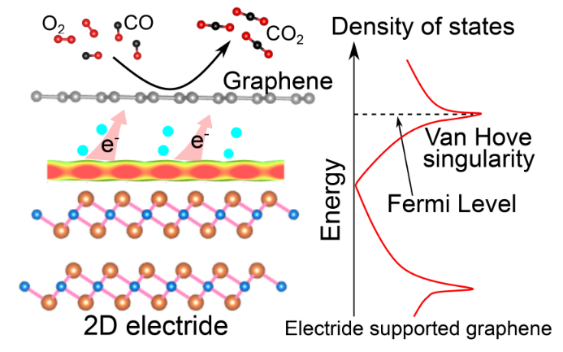Recently, Prof Jia’s group proposed a new catalytic concept about “Van Hove Singularity Catalysis”, and the work is published on Journal of Physical Chemistry Letters. https://pubs.acs.org/doi/abs/10.1021/acs.jpclett.1c03861.
It has been well-established that Van Hove singularity (VHS), a saddle point in the electronic band structure with highly localized density of states, can give rise to exotic physical phenomena, such as magnetism, superconductivity and charge density wave. In majority of the bulk material systems, the VHS usually is remote from the Fermi level, which hinders the practical manipulation. In stark contrast, the VHS is tunable to be well-aligned with the Fermi level and serve as a surface state in surface or two-dimensional systems with reduced dimensions. Hence, we tentatively call this ‘surface Van Hove singularity (SVHS)’. As along as SVHS appears, rich and intriguing surface phenomenon is enabled apart from the intrinsic bulk properties, among which the surface catalysis is closely relevant, considering their giant carrier reservoir nature and strong localization feature.
After releasing the concept of the ‘surface Van Hove singularity catalysis’, we then provide delicate proof using the state-of-the-art first-principles calculations within density functional theory. This is achieved by choosing two prototypical surface systems with SVHS, namely graphene/Ca2N (Gra/Ca2N) heterojunction and the Pt2HgSe3 (001) surface. The CO oxidation reaction as prototype catalyzed by the selected systems is examined. Indeed, SVHS existed in both systems serves as an electron bath facilitating the O2 adsorption and subsequent CO oxidation, which can be justified by the remarkably low energy barriers of the rate-determining steps of 0.37 and 0.59 eV for Gra/Ca2N and Pt2HgSe3, respectively.

Figure 1: The schematic diagram for van Hove singularity catalysis
We emphasize the importance and unique features of SVHS catalysis, that is, the well-defined and uniformly distributed active sites, and the tunability of the chemical activity of the SVHS. The former distinguishes itself from the popular defect or heteroatom-doping strategy, which are distributed randomly and hard to identify. The latter promises SVHS catalysis efficient in entirely different chemical reactions. These findings could provide new physical insight into the role of Van Hove Singularity and, in subsequent, stimulate the design of highly efficient catalysts.
The first author of this paper is Dr. Liangliang Liu of Key Laboratory of Special Functional Materials, and the corresponding authors are professor Dongwei Ma and Yu Jia. This work is supported by the National Natural Science Foundation of China and the Key Scientific Research Foundation for universities of Henan Province.